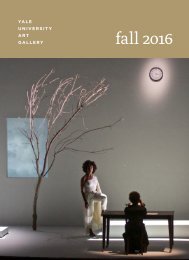MagSpring2015_220_final_onlinetest
You also want an ePaper? Increase the reach of your titles
YUMPU automatically turns print PDFs into web optimized ePapers that Google loves.
Special Exhibition<br />
The Critique of Reason: Romantic Art, 1760–1860<br />
The Critique of Reason: Romantic Art,<br />
1760–1860 is the first major collaborative<br />
exhibition between the Yale University<br />
Art Gallery and the Yale Center for<br />
British Art. The exhibition opens at the<br />
Gallery on March 6, bringing together<br />
over 300 works from the museums’<br />
holdings, augmented by special loans<br />
from select private collections and<br />
Yale’s Lewis Walpole Library. The<br />
Critique of Reason features paintings,<br />
sculptures, medals, watercolors, drawings,<br />
prints, and photographs by such<br />
iconic artists as William Blake, John<br />
Constable, Honoré Daumier, Pierre-<br />
Jean David d’Angers, Eugène Delacroix,<br />
Théodore Géricault, Francisco de Goya,<br />
John Martin, and Joseph Mallord<br />
William Turner. Challenging the<br />
notion that Romanticism stood in<br />
opposition to reason and the scientific<br />
method, the exhibition’s eight thematic<br />
sections reveal the Romantics as<br />
attentive explorers of their natural and<br />
cultural worlds as well as artists deeply<br />
engaged with the mysterious and the<br />
spiritual.<br />
Two galleries in the exhibition<br />
explore the tension between subjective<br />
expression and scientific description in<br />
the Romantic era. “Landscape and the<br />
Perceiving Subject”—inspired directly<br />
by Constable’s remark that “painting is<br />
a science and should be pursued as an<br />
enquiry into the laws of nature”—is the<br />
largest section in the show and boasts<br />
some of the most stunning works in<br />
Yale’s collections, including those by<br />
Constable, Jean-François Millet, and<br />
Turner. The paintings, watercolors, and<br />
prints exemplify how the Romantics<br />
used their careful observations of<br />
nature, space, light, and weather to<br />
evoke mood and meaning.<br />
“Nature: Spectacle and Specimen”<br />
showcases works that straddle the line<br />
between art and science. These include<br />
stunning views of Mount Vesuvius by<br />
Turner and anatomical studies by such<br />
artists as Delacroix and George Stubbs,<br />
who present exacting depictions of<br />
mammalian anatomy while dramatizing<br />
the wildness of their subjects using<br />
highly theatrical compositions.<br />
The Romantics came of age in<br />
an era of colonial expansion, travel,<br />
trade, and ethnographic study, which<br />
led to both scholarly discourse and<br />
popular fictions regarding non-<br />
Western cultures and locales that<br />
stimulated the artistic imagination.<br />
The works in “Distant Lands, Foreign<br />
Peoples” range from studies of exotic<br />
costumes by Eugène Fromentin, John<br />
Frederick Lewis, and Auguste Raffet<br />
to watercolors and photographs that<br />
transform Egyptian monuments into<br />
Romantic ruins.<br />
The prevailing notion of the<br />
Romantic artist as an isolated dreamer<br />
given to introversion and removed<br />
from society and politics is refuted<br />
throughout the section titled “The<br />
Artist as Social Critic.” Many artists<br />
from this period were vociferous<br />
social commentators, carrying out the<br />
Enlightenment ideals of free thought<br />
and action. Yale’s stellar print collections<br />
are brought to the fore here with<br />
rarely exhibited works by Daumier and<br />
Géricault and the full suite of Goya’s<br />
galvanizing Disasters of War (etched<br />
1810–20, published 1863).<br />
“Religion after the Age of Reason”<br />
illustrates the changing approaches<br />
to sacred themes in the Romantic<br />
era. Diverse subjects reveal that the<br />
Romantic artists’ engagement with<br />
religion was not a naive reversion<br />
to mysticism, but rather a means to<br />
extend their cultural relevance. John<br />
Martin’s The Deluge (1834) and William<br />
Blake’s Jerusalem: The Emanation<br />
of the Great Albion (1804–20), for<br />
instance, show the Romantics directly<br />
addressing the place of religion by<br />
individualizing biblical themes<br />
and religious experience. Closely<br />
connected is the section on “The<br />
Literary Impulse,” which features an<br />
array of works inspired by literature,<br />
including classical mythology and<br />
modern poetry. Henry Fuseli’s Dido<br />
(1781), Delacroix’s illustration for<br />
Goethe’s Faust (1827), Géricault’s<br />
lithographs inspired by Lord Byron<br />
(1823), and Blake’s illustrations for<br />
Dante (1827) all illustrate a dynamic and<br />
evolving relationship between word<br />
and image in the Romantic period.<br />
Romantic portraiture emphasized<br />
the sitter’s psychological state, evoking<br />
an empathetic relationship between<br />
subject and viewer. The portraits on<br />
view in “Beyond Likeness” exhibit<br />
different styles and techniques, from<br />
the expressive brushwork of Delacroix<br />
and Thomas Lawrence to intimately<br />
conceived medals by David d’Angers.<br />
Also on view are early, poignant photographic<br />
portrayals of such Romantic<br />
figures as Victor Hugo and Charles<br />
Baudelaire.<br />
While many sections of the<br />
exhibition explore the shifting<br />
ideas and pictorial content that<br />
preoccupied the Romantics, “The<br />
Changing Role of the Sketch” shows<br />
how technical processes changed in<br />
tandem with widening ambitions<br />
for art. Constable’s cloud studies and<br />
Gustave Courbet’s Hunter on Horseback<br />
4



